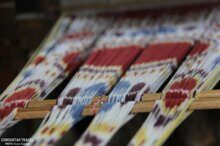The Ferghana valley is the" silk center" of Uzbekistan, and the city of Margilan is a place where the oldest traditions of silk weaving, not lost in the age of industrialization, have been preserved. The traditions of sericulture and weaving in the valley go back to the times of the "silk road", when enterprising traders "Davani" under the guise of traveling monks brought the first cocoons of silkworms hidden inside road staves from the Celestial Empire.
Margilan, already in the X century, was quite a prominent craft center and was especially famous for its silk fabrics. It has its own deeply national local school with its own style and techniques. For this reason, weavers from all over Central Asia have been studying in Margilan for a long time, adopting the Margilan style of silk and semi-silk fabrics, which formed the basis of the national style of handcraft fabric ornamentation that has come down to our days. Such a high level of silk weaving could only be based on the deep traditions and experience of many generations of masters. Let us also remember that the flourishing of fabric production is always closely linked to the way of life of the people and political stability - only under favorable economic conditions, the production of artistic fabrics was strengthened and developed. Since the XIV century, the importance of Margilan as a large and rich craft center with a vast agricultural district increases. During the time of the Kokand Khanate (XVIII-XIX century) Margilan was one of the centers of the region and was ruled by close relatives of the khans, playing a large role in the country's politics, economy and life. It was during this period that artistic weaving in Margilan reached its greatest heyday.
For centuries, in the East and West, Margilan silk was famous for its unique pattern. Heavy semi – silk fabrics-bekasams, banoras and adras are well known; light and thin silks for women's clothing-Shaya and Madali; dense, well-draped purple fabrics-turme; picturesque, completely original in contrast and at the same time harmony of colors – Abra satins. The most popular fabrics have always been patterned Abra silks, the beauty of which is achieved by special dyeing techniques (abrband) and the selection of complex ornamental compositions when filling the loom. The second name is Abra-ikat, it is under this name that this fabric is known in the West.
"ADB "means" cloud" in Persian. It is difficult to determine the time of appearance of ABR dyeing, but one legend says that the masters imitated the reflections in the pond water running clouds and another rainbow stains resulting from oil spilled in the house. Master Sobirjon jokingly adds that, in any case, there are legends about when there were no cocoons, but there are no stories about a time when there was no abrband. When he shows what the peculiarity of the method of dyeing abrband is, you are surprised at the simplicity and originality of the idea and at the same time the complexity of the technique, based on painstaking manual labor and art. Truly, all genius is simple! If, according to the classic genre, the ready-made fabric is colored, then here the warp threads are painted in different colors in separate sections long before the weaving process, which gives a wide scope for the imagination of the masters. Many researchers suggest that the Ferghana valley is the birthplace Avrovich tissues.
Between the paint shop and the weaving shop, I have time to ask my guide why the factory Director called his silk "wild". "This is not what we called it, but the foreigners. In most cases, our silk is made by hand using old technologies. The whole process-from feeding grain to getting the finished fabric-is manual, so our silk is called wild, i.e. handcrafts."
Indeed, the raw material for silk-silkworm cocoons-is now obtained at home, the worms are kept in the courtyard of an Adobe house in a special room that provides room temperature and protection from the sun. From tiny sand-like eggs (Gren) to mature silk cocoons, they grow in 28-29 days - from mid-April to mid-may, with constant feeding. Voracious silkworms do nothing but eat the tender mulberry leaves that need to be picked at dawn while they are wet. The thread from the cocoons is also unwound manually, using grandfather's designs and ordinary cauldrons and tools. I tried unwinding the cocoons myself, using an ordinary stick to start with, and then turning a large wheel. An amazing feeling! The wonderful transformation of cocoons into a skein of the finest threads is so unusual and amazing that you feel like a sorceress…
To color "wild" silk, Margilan masters most often use extracts from the roots, fruits, and leaves of such dye plants that grow in Uzbekistan. These are Royan (red madder), pomegranate, walnut, acacia, sophora, japonica, onion, mallow, saffron. Imported black tea, Indigo, cochineal, henna are used. It was also a surprise that ordinary "Usma", the juice of which we paint our eyebrows to make them black, is also used by handcrafters. Vegetable dyes have a natural harmony that does not give a sharp color, but on the contrary, the colors smoothly transition from one shade to another, filling the fabric with a rich color. The cream color that walnut leaves give cannot be confused with any other, and the most delicate color from pomegranate crusts is comparable only to the morning dawn, is indescribable in words.
And here I am at the loom. The wooden structure with many pedals is painted with colors and patterns; it is original and simple at the same time. The weaver works so fast that I don't have time to photograph the process, content to shoot the multicolored Abra threads that run from the main machine to the opposite wall of the shop. What colors! Here is a canvas with white clouds floating across a blue sky or reflecting in the water of a river, and here the water is green and the clouds are bluish-white… The riot of red and maroon sky is calmed again by white clouds, probably the evening sky, a bloody sunset. My imagination was so wild that I decided to share my guesses with the master. Sobirjon smiled slyly: "And you also ask why our silk is called "wild"".




